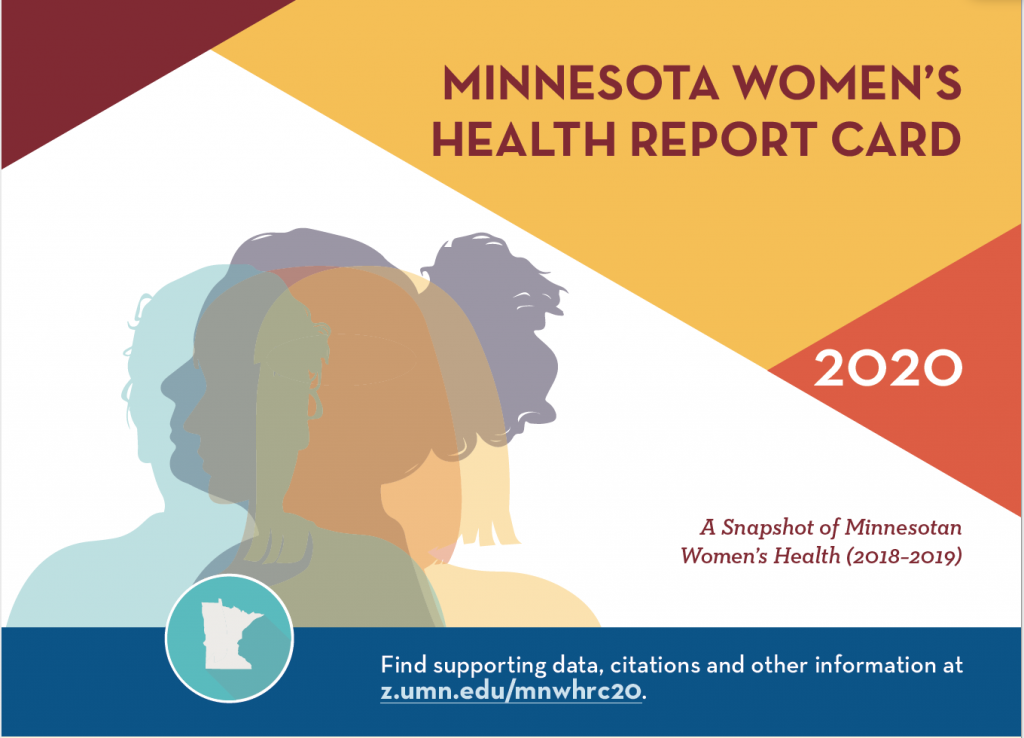
–Women’s Health Report Card (pdf)
Introduction:
There are many local and national data sources that can be accessed to learn about the status of women’s health in Minnesota. However, there is no one source that provides Minnesotans with a comprehensive review of the specific indicators of and barriers to women’s health. In order to paint a broad picture of how Minnesota’s women are faring, we have combed through the data and compiled the Minnesota Women’s Health Report Card (MN-WHRC) to provide citizens, public health professionals, policymakers and others with a short, visual synopsis that highlights key areas of women’s health.
To avoid the duplication of other existing efforts, this report focuses on the health of women ages 18 and up unless otherwise indicated. Because the MN-WHRC is intentionally brief, much of the supporting data, citations and other information are made available on this website.
About this Report Card:
Working closely with colleagues and the Minnesota Department of Health’s (MDH) Center for Health Statistics, Child and Family Health Division, and Health Promotion and Chronic Disease Division, we have carefully designed the Minnesota Women’s Health Report Card (MN-WHRC) to help visualize and reflect the health indicators specific to our state’s unique demographics. The MN-WHRC will be produced every other year as new data becomes available, and with the intent of providing a comprehensive review and comparison across the years.
These data reflect the daily lived experiences of women’s lives, and can be used to inform Minnesota’s practice and policies, thus offering the opportunity of improving the near- and long-term health outcomes for women.
Finally, in recognition of the rich diversity of our state’s immigrant and refugee populations, the Report Card went through a multi-person team translation and review. It is also available in Spanish, Hmong and Somali.
About the Data Sources:
The MN Women’s Health Report Card is produced using a variety of data sources and State reports. The data sources vary based on year and method of data collection. However, most of the data used for this initial report card are data that were reported in 2018. Some sources only report on the extended periodic basis while some others report annually. For instance, data points such as postpartum depression relies on the Pregnancy Risk Assessment Monitoring System (PRAMS) which only reports in two-year increments. The MN’s 2011 Behavioral Risk Factor Surveillance System (BRFSS) provides the latest update on the Adverse Childhood Experiences (ACEs) in MN. The MN Health Statistics Annual Summary and the MN Adult Prison Population Summary are published every year. Hence, the MN Women Health Report Card used a mix of data ranging from 2011-2020. The data collection year is indicated next to each heading. Some topic areas use data collected in different years.
Unless otherwise indicated, all data are for women aged 18 years or older. Samples size also differs from each data reporting system as well. It is important to show data by race and ethnicity for targeting resources and interventions toward populations in need. Though, one of the limitations is that some data reported were not broken down by gender and race/ethnicity.
The terms “female” and “woman/women” are used interchangeably throughout the MN-WHRC based on the data collection methods and reporting of the data sources. We recognize that these terms are not inclusive of all gender identities, and it is important to address the current limitations of language within research and in the MN-WHRC. We recommend that future research and data reporting address the language used in alignment with the populations they are working with.